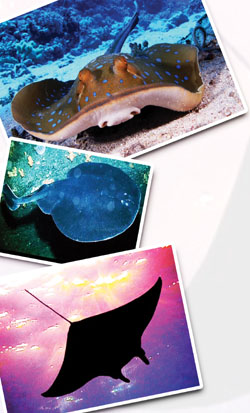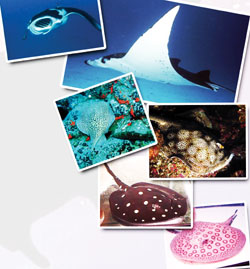|
observer |
|
|
|
|
|
OTHER LINKS |

|

|

|
|
|
|
Rays are fish without bones. They have only cartilage (the tough, fibrous substance our nose bridges are made of), in their bodies. There are many species of rays ranging in size and colour in the oceans, seas and even some estuaries in the world. Though the majority of rays are found in salt water, some species live in fresh water too. They are mostly the smaller kind.
All species of rays are closely related to the most feared marine creature - the shark! In fact, some believe that the ray is nothing more than a flattened version of the shark. Does this mean, the rays are as dangerous as the sharks? Well, remember not all sharks are dangerous and so, even when it comes to rays, not all species are harmful to man or other fish.
Rays not only vary in colour from species to species and even from male to female, but also in size. The smallest which is the Short nose electric ray is the size of a pancake, about 4-10 inches in length and weighs only a pound. The biggest of all rays, the Manta ray also known as the Devil's ray, measures about 25 feet across its pectoral fins or 'wings' and weighs about 3,000 kilograms.
These unusual, flattened fish are social creatures and most species live in groups amounting to even thousands. Some species however prefer to live alone. In general, rays have flat bodies. Even their skulls are flat! Tails are elongated (lengthy), although the length varies in some species. While some rays have whip-like tails, others have short stubby tails. Most species are harmless, but some species such as the stingrays have toxic spines on their tails that could cause vomiting, nausea, muscle paralysis and even cardiac failure.
|
|
The rays are carnivores, and live on microscopic plankton, small crustaceans, worms and molluscs. They are mostly 'bottom feeders'. They generally hunt for food on or near the bottom of the sea bed. Most species are active hunters. However, as rays have their eyes on the top of their bodies and the mouths at the bottom, they hunt mostly by sense of smell and electro receptors similar to that of sharks.
Some rays, like the Manta rays filter feed. Once they find prey, they dislodge it, and grab it with their rostral lobes located on either side of the head. (These flexible lobes or horns, especially in the Manta ray were what earned it the name the Devil's ray.) The food is then crushed with plate-like teeth located in the lower jaw, in most species.
The Manta ray, the largest with some recording a length of 29 feet across, is considered to be a graceful swimmer or 'flyer' as most of the rays glide in the water as effortlessly as birds, with the help of pectoral fins. The Manta ray's diamond-shaped body plan contributes to its graceful movements which divers enjoy observing. Some rays are oviparous (laying eggs) while others reproduce by giving birth to live young that develop in the womb. The rays give birth to one or two pups.
Find out more about the many species of rays that inhabit the oceans and seas of the world...
Fact file
* The earliest known rays date from the Jurassic period, about 150 million years ago.
* They can be found from the poles to the tropics, typically around coral reefs, and even in freshwater in South America, Africa and South East Asia.
* In general, rays are black, greyish-blue, greenish or reddish brown on top with a white underside.
* These denizens of the deep are among the least understood marine species, which numbers about 500 species, including skates.
* Rays have five pairs of gills to breathe. They however lack a 'swim bladder' like most fish. While most fish use air-filled bladders to float, rays use their oily livers to maintain buoyancy.(ability to keep from sinking)
* If the ray stops swimming, it would sink to the bottom.
* More than half the species of rays are over 20 inches in length.
* Some rays have thorn-like scales on the body which they use against predators.
* Rays have a high ratio of brain weight to body weight. They are considered intelligent, perhaps even smarter than sharks!
* Some rays have electric power to stun humans. Ancient Greeks used such rays for shock therapy. These rays have a special organ that generate electric current. The Lesser electric ray can deliver a powerful electric shock ranging from 14-37 volts.
* The Bluespotted stingray is a favourite aquarium species. The Bluespotted Ribbontail ray is a timid creature with an oval shaped disc. It has two venomous spikes towards the tip of the tail. It grows up to 2.2 ft.
* The Manta ray, though large is harmless.
* The Round stingray has a nearly circular shaped body with a tail that's shorter than the length of the disc. It has no dorsal fins, but has a rounded caudal fin which most rays lack.










